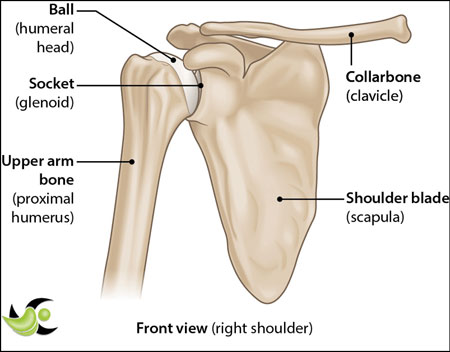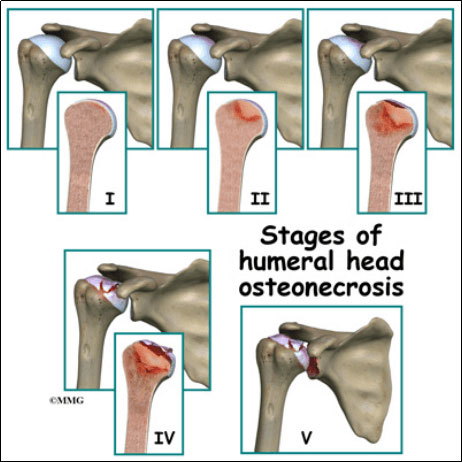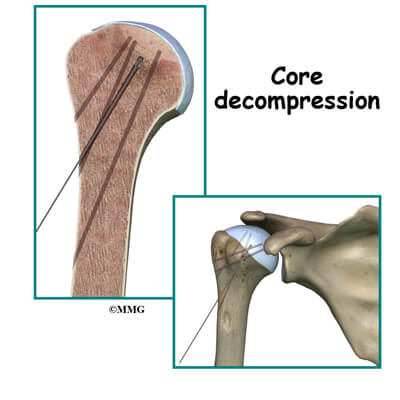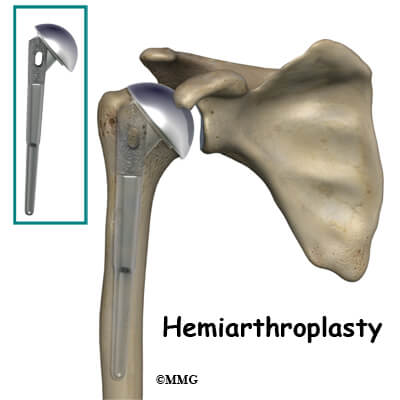Blog
Avascular Necrosis of Shoulder
Posted on 17th February 2022
Blood is needed to sustain life and promote the health of all the body’s tissue. If the blood supply to a tissue or an organ is interrupted, it can lead to tissue death. Similarly, when the blood supply to the bone is interrupted, it causes the death of bone tissue or Avascular Necrosis.
Avascular necrosis (AVN) is common in certain joints, such as the hip, ankle, knee, and shoulder.
AVN of Shoulder:
The shoulder is one of the complex joints in the human body. It consists of the humerus (upper arm bone) that fits into the scapula (shoulder blade), like a ball and socket. The humeral head is covered with a smooth, white tissue called articular cartilage. The articular cartilage allows the bones to glide over each other smoothly.

Image adapted from https://shoulderbuzz.com/shoulder-anatomy/
Fig.1. Anatomy of Shoulder
Blood vessels supplying blood to the humerus enter from various locations and branch out inside the humeral head towards the periphery. In avascular necrosis, the blood supply to the humeral head is lost leading to bone necrosis or bone death. In simpler terms, the shoulder humeral head suffers a stroke due to the loss of blood supply.
Causes & Risk Factors:
- Trauma
- Excessive alcohol consumption
- Long-term use of corticosteroids
- Kidney or bone marrow transplant
- Certain conditions like Sickle Cell Anemia
- Chemotherapy
- Idiopathic (unknown cause)
Symptoms:
The common symptoms of AVN of the shoulder are:
- Shoulder Pain
- Crackling sound on movement
- Reduced mobility
- Stiffness of the joint
Initially, the symptoms are not consistent, but as the condition progresses, the symptoms become more consistent and may even interfere with sleep.
Diagnosis:
The imaging techniques used for the diagnosis of shoulder AVN are X-rays, MRI, and bone scans.
Treatment:
The doctors determine the treatment based on the stage of AVN. Hence, diagnosis plays a major role in identifying the stage of the disease.

Image adapted from eOrthopod.com
Fig.2. Stages of Humeral Head Avascular Necrosis or Osteonecrosis
Stage I is the initial stage and can be treated easily. However, stage V is the most advanced stage. In this stage, the humeral head collapses, and the socket is damaged as well.
The treatment options involve the following:
A. Non-surgical Treatment
The non-surgical treatment options include:
1. Bisphosphonates:
Bisphosphonates cease the disease progression, prevent bone collapse and the need for invasive surgery.
2. Lipid-lowering agents:
Lowering the level of lipids in blood can help prevent vessel blockages, which in turn cause avascular necrosis.
3. Vasodilators:
Vasodilators dilate or prevent the constriction of blood vessels, which allows greater blood flow.
4. Non-steroidal anti-inflammatory drugs (NSAIDs):
NSAIDs such as ibuprofen or naproxen sodium can relieve the pain caused by avascular necrosis.
5. Exercises & Rest:
Certain exercises and rest can help reduce pain and increase the range of motion of the affected joint.
The main objective of these medications is to restore the blood supply, promote the growth of newer bones, increase mobility and reduce pain.
B. Surgical Treatment:
Surgical intervention may be needed in the more advanced stages of avascular necrosis.
1. Core Decompression

Image adapted from eOrthopod.comFig.3. Core Decompression
Core decompression involves the drilling of small holes from the healthy bone to the area of necrosis in the humeral head. This creates channels that allow new blood vessels to grow into the necrotic area.
2. Bone Grafting:
Bone grafting involves the replacement of the necrotic or dead bone with the donor's bone, which is usually taken from the patient’s hip. It is used in mild to moderate cases of AVN.
3. Joint Replacement or Hemiarthroplasty (partial shoulder replacement):

Image adapted from eOrthopod.com
Fig.4. Hemiarthroplasty (partial shoulder replacement)
Joint replacement is recommended for advanced stages. A hemiarthroplasty or partial shoulder replacement may be used when only one side of the joint is affected. Doctors recommend full joint replacement surgery only if both the humeral head and socket are severely damaged.
4. Regenerative medicine treatment:
Bone cell therapy is a new procedure that can effectively treat the AVN of the shoulder joint. During the treatment, osteoblasts (bone-forming cells) are injected into the affected area to promote the growth of new bone. It can also be used for treating shoulder muscle pain.
Patient Testimonial:
In May 2019, Hitesh underwent stem cell therapy for shoulder AVN. Soon after the treatment, his pain reduced significantly. His range of motion improved gradually after the treatment. Today Hitesh can go about his daily routine & says, "my shoulder is 1000% better than before"
References:
< Back To Blog